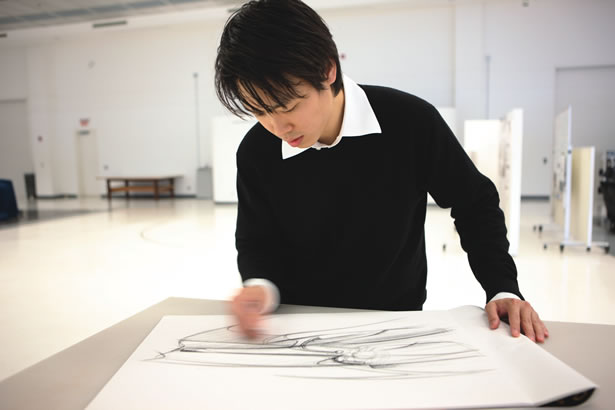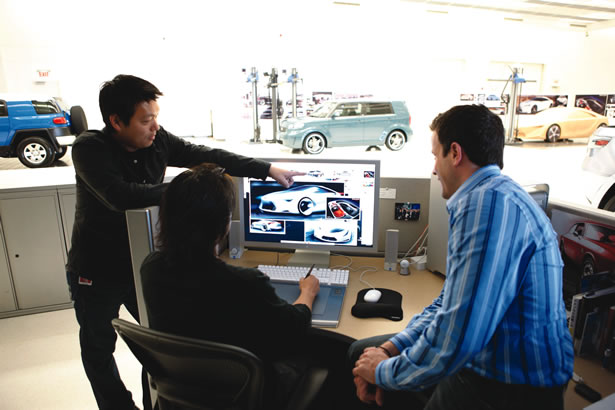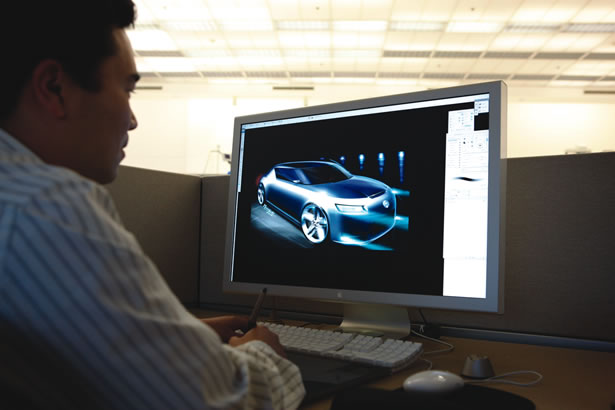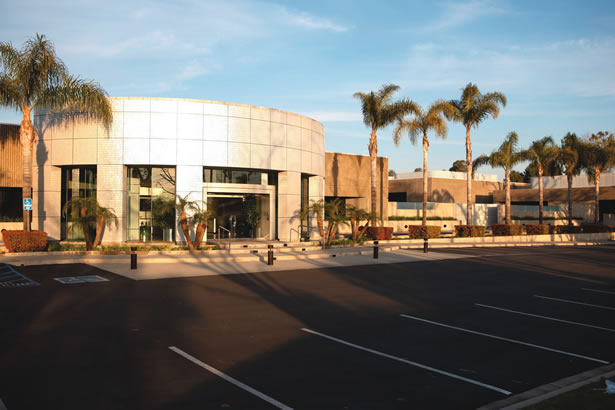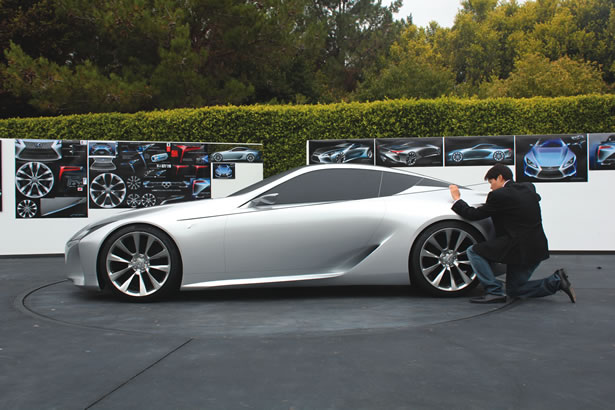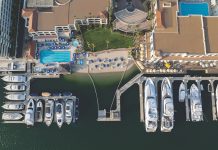Newport’s very own Calty Design Research studio takes top honors at the 2012 Detroit Auto Show with the Lexus LF-LC concept car.–By Bruce Porter
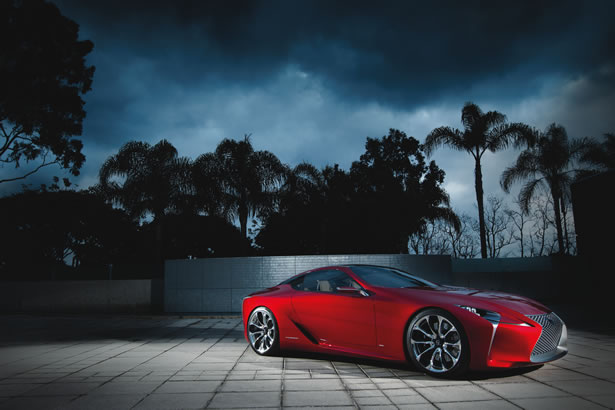 In the late 1980s, Japanese automakers unveiled luxury brands to compete with Cadillac and celebrated European brands like BMW and Mercedes. Overall sales figures and many attractive cars notwithstanding, Lexus, Acura and Infiniti have arguably yet to produce an iconic brand identity—one for the ages. Until now, perhaps. At the 2012 Detroit Auto Show, two models garnered all the accolades, the Lexus LF-LC and the new Acura NSX. What made it intriguing—and a heck of a lot more fun—is the ongoing rivalry between the two companies. When it came time to cast ballots, though, there was no doubt as to which would prevail. The Lexus LF-LC won Best Concept and, indeed, was hailed by many insiders as the best concept car ever.
In the late 1980s, Japanese automakers unveiled luxury brands to compete with Cadillac and celebrated European brands like BMW and Mercedes. Overall sales figures and many attractive cars notwithstanding, Lexus, Acura and Infiniti have arguably yet to produce an iconic brand identity—one for the ages. Until now, perhaps. At the 2012 Detroit Auto Show, two models garnered all the accolades, the Lexus LF-LC and the new Acura NSX. What made it intriguing—and a heck of a lot more fun—is the ongoing rivalry between the two companies. When it came time to cast ballots, though, there was no doubt as to which would prevail. The Lexus LF-LC won Best Concept and, indeed, was hailed by many insiders as the best concept car ever.
Love it or hate it, the 2+2 hybrid coupe elicits a reaction—Lexus has drawn a line in the sand. The LF-LC dispels any notion that Japanese cars lack emotion or passion. The hourglass-shaped mesh front grille is a particularly bold statement. The fastback body style combines fluid, muscular lines with the stylistic inventiveness that used to be considered unique to the Italians. The interior reflects the same daring aesthetic. Being seated behind the wheel feels like being encapsulated in a space-age cockpit ready for blast-off, yet without sacrificing the luxurious comforts of leather seats and tastefully appointed wood accents. Touch-screen boards on the center console and doors control the entertainment center, windows, mirrors and seat adjustments.
“We launched the Lexus LF-LC sports coupe in Detroit, and it was great,” says Kevin Hunter, president of Calty Design Research. “We use these cars as a kind of test to see how the public reacts, and if it’s really positive, it gives us more incentive to build the car.”
Although Kevin declined to tip Lexus’ hand, it’s rumored the LF-LC may be headed for production soon, possibly under the name LC 600h, and could hit showrooms as early as 2015.
Calty Design
Calty, the first automobile design studio in Southern California, opened its doors in 1973 and moved to its present location in 1978. In 1990, the company added two buildings to its complex, effectively tripling in size.
For its 65 employees, the 90,000-square-foot space provides a relaxed working environment. There are separate buildings—exterior, interior and color—for each component of the overall design. Two courtyards with distinctive environmental features provide designers with a place to take their work outside to evaluate and exhibit. Inside the lobby, along with the award from the recent Detroit Auto Show, stands the CT 200h, which was based on the LF-Ch Concept designed by Calty. The LF, incidentally, stands for Lexus Future.
Sensitive portions of the buildings are strictly off limits to the public, but the unrestricted hallways feature fascinating automotive design pictorials, like the history of colors and fabrics. There are even examples of the clay modelers’ sculptures of the female form, which are a whole lot closer to something you’d see at LACMA than at Color Me Mine.
This is where the future of automotive design takes place, and not all of it centers on visually pleasing contours and ultra-modern interiors. Kevin offered the engine compartment as one example of how cars will be different in years to come.
“We can take the same power and separate it into smaller motors, which we call in-wheel motors, so each wheel has a motor that drives the car,” he explains. “It frees up a lot of space for people or cargo or safety systems, not just the power plant.”
The men and women who designed the cars on the highways are exactly the kinds of super-engineers you’d imagine, though perhaps a bit more grounded in reality. “We’re a bunch of geeks,” Kevin admits good-naturedly. “Part science, part art. But really what we do is an artistic endeavor, and it’s a lot of fun.” To be sure, every designer at Calty is an absolute automotive fanatic, with a healthy obsession that ranges from engine compartments to headlights, and the next great sports car is on all of their wish lists. “The first thing that ran through my head was this is an incredible project, an incredible opportunity, to design a sports car, a dream car—a halo car for Lexus,” says Edward Lee, the fresh-faced 28-year-old senior designer of the LF-LC exterior.
Bringing Design to Life
The initial impetus for the LF-LC came from the Lexus LFA, a $400,000, mostly hand-built supercar. Of the 500 currently in production, fewer than 200 will be coming into the U.S.
“It’s hard to get one,” Kevin explains. “We thought, it’s rather unobtainable for most people, but why not take some of that energy and bring it down to a more obtainable level? The LF-LC is one answer to that. As exciting and expressive as it is, the price point is within the premium segment. It’s a little more affordable.”
“We started with a blank sheet of paper,” Edward adds, “and we were given the freedom to be as creative as possible. Throughout the project, we had to keep our passion at the highest level possible, to always be motivated, to always be looking for inspiration.”
The inspiration for the LF-LC took on all sorts of forms, not least the geographical and environmental idiosyncrasies of the Southern California landscape. Kevin, who grew up in Detroit, quipped at one point that he sometimes has to pinch himself on the way to work, driving up the Coast Highway from his Dana Point home. It might sound like lip service to anyone who has lived here all of their lives, but virtually every automotive manufacturer has design studios in California these days. But the designers at Calty didn’t stop at sun, sea and surf—they sought out their own influences.
In one instance, Edward and his team started with “very thin pieces of acrylic and vacuum-formed them over these natural forms, like a leaf, to create, with aluminum, these really interesting metallic pieces. We took those forms and created all these interesting contours,” he explains. The challenges of designing and building a modern vehicle, much less the greatest concept car ever, go far beyond pencil sketches and being adroit with modern 3D graphics software. Calty designers have to balance their imaginations with the practical realities of engineering and production limitations.
“Even though we’re pushing the boundaries, we also had to think about what could be executed,” Edward says. “As a designer, it’s our job to create something that’s interesting, but at the same time to create something that’s feasible.”
Most car buyers never think about the monstrous hurdles of creating a car from scratch. They simply expect everything under the hood to work; they sign on the dotted line because they like the color, the way it feels behind the wheel, the way it looks, how it fits their personality. And the LF-LC has an extremely aggressive personality, perhaps best exemplified by its fantastic front spindle grille. Although it resembles the Lexus GS, Calty modified it to its logical extreme.
“It’s part of the brand identity,” Edward elaborates, “but what we did was to make a more sculptural interpretation of it. The front of the car, the spindle grille, stands as the cornerstone of the car, where all the lines emanate, so you get a connection with all the surfaces of the body.”
Likewise, the interior showcases equally surprising architecture with its center console, almost dividing the front into two separate cockpits. “It has beautiful line work that stretches from the collar of the car to the rear part,” says Ben Chang, senior designer of the interior. Beyond the perfunctory duties of driving, the LF-LC offers enough high-tech gadgets to make even Apple employees jealous. “It’s a very good combination of an art piece that showcases technology,” Ben adds with a wry smile.
Driving Into the Future
While Calty executives can’t say exactly when there will be flying cars on the road, there’s a palpable sense of progress in the automotive industry. At any given time, the designers are working on 10 different projects, some of which will get tossed into the trash can, some of which will go on to prestigious auto shows, and fewer yet that will make it to the production line.
As automotive management teams incrementally relinquish control to designers, the beneficiary appears to be the consumer. Modern technology allows designers to be less slavish to engineering hard points, such as mandatory wheelbases or body lengths. Better performance for better-looking cars is the new catch phrase. And design studios like Calty are leading the charge.
“That’s what’s exciting about where we’re going with our company right now,” Kevin says. “We’re turning into a design-driven company, where designers are having a big, big say in the proportions of the vehicle architecture—so we can make more exciting cars.” NBM


